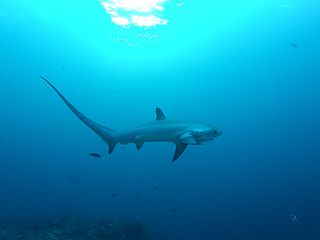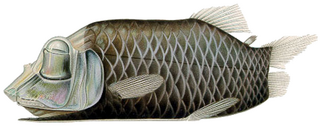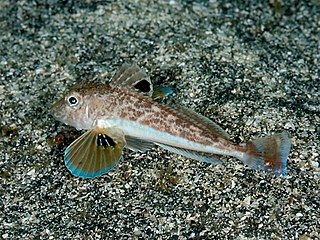
A tuna is a saltwater fish that belongs to the tribe Thunnini, a subgrouping of the Scombridae (mackerel) family. The Thunnini comprise 15 species across five genera, the sizes of which vary greatly, ranging from the bullet tuna up to the Atlantic bluefin tuna, which averages 2 m (6.6 ft) and is believed to live up to 50 years.

Thresher sharks are large lamniform sharks of the family Alopiidae found in all temperate and tropical oceans of the world; the family contains three extant species, all within the genus Alopias.

Lepidoteuthis grimaldii, also known as the Grimaldi scaled squid, is a large squid growing to 1 m in mantle length. It is named after the Grimaldi family, reigning house of Monaco. Prince Albert I of Monaco was an amateur teuthologist who pioneered the study of deep sea squids by collecting the 'precious regurgitations' of sperm whales. The Grimaldi scaled squid was first collected from the stomach contents of a sperm whale. It is a widely distributed species in tropical and subtropical areas of the North and South Atlantic, the southern Indian Ocean and the Pacific Ocean, where it has been recorded off Japan and in the west Pacific.

Barreleyes, also known as spook fish, are small deep-sea argentiniform fish comprising the family Opisthoproctidae found in tropical-to-temperate waters of the Atlantic, Pacific, and Indian Oceans.

The largehead hairtail or beltfish is a member of the cutlassfish family, Trichiuridae. This common to abundant species is found in tropical and temperate oceans throughout the world. The taxonomy is not fully resolved, and the Atlantic, East Pacific and Northwest Pacific populations are also known as Atlantic cutlassfish, Pacific cutlassfish and Japanese cutlassfish, respectively. This predatory, elongated fish supports major fisheries.

The devil fish or giant devil ray is a species of ray in the family Mobulidae. It is currently listed as endangered, mostly due to bycatch mortality in unrelated fisheries.

Pteroidichthys is a genus of marine ray-finned fish belonging to the family Scorpaenidae, the scorpionfishes. The scorpionfishes in this genus are distributed in the Indian and Pacific Oceans.

Thunnus is a genus of ocean-dwelling, ray-finned bony fish from the mackerel family, Scombridae. More specifically, Thunnus is one of five genera which make up the tribe Thunnini – a tribe that is collectively known as the tunas. Also called the true tunas or real tunas, Thunnus consists of eight species of tuna, divided into two subgenera. The word Thunnus is the Middle Latin form of the Greek thýnnos – which is in turn derived from thynō. The first written use of the word was by Homer.

The yellow-edged lyretail also known as the yellowedge coronation trout, fairy cod, lunar tail rock cod, lunartailed cod, lyre-tail cod or moontail seabass,, is a species of marine ray-finned fish, a grouper from the subfamily Epinephelinae which is part of the family Serranidae, which also includes the anthias and sea basses. It is found in the Indo-Pacific region and is more common than the congeneric white-edged lyretail.

The brownsnout spookfish or brown-snout spookfish is a species of barreleye in the family Opisthoproctidae. It and the glasshead barreleye fish are the only vertebrates known to employ a mirror, in addition to a lens, to focus an image in its eyes. This species probably has a worldwide tropical and temperate distribution; in the Atlantic Ocean it is known from Bermuda, the Bahamas, the Greater Antilles, and the Gulf of Mexico, and in the Pacific Ocean it is known from the California Current region and the South China Sea. It is found in the mesopelagic and bathypelagic zones at a depth of 500–2,400 meters (1,600–7,900 ft), but usually occurs below 1,000 meters. In the Gulf of Mexico it is found shallower, at 310–460 meters (1,020–1,510 ft).

Macropinna is a genus of ray-finned fish belonging to Opisthoproctidae, the barreleye family. It contains one species, M. microstoma. It is recognized for a highly unusual transparent, fluid-filled shield on its head, through which the lenses of its eyes can be seen. It was originally believed that the tubular eyes of this fish were fixed in place and, therefore, only provided a tunnel vision view of what was seen above its head. However, in 2008, scientists discovered that its eyes were able to rotate both up and forward in its transparent shield. M. microstoma has a tiny mouth and most of its body is covered with large scales. The fish normally hangs nearly motionless in the water, at a depth of about 600 metres (2,000 ft) to 800 metres (2,600 ft), using its large fins for stability and with its eyes directed upward. In the low light conditions it is assumed the fish detects prey by its silhouette. MBARI researchers Bruce Robison and Kim Reisenbichler observed that when prey such as small fish and jellyfish are spotted, the eyes rotate like binoculars, facing forward as it turns its body from a horizontal to a vertical position to feed. Robison speculates that M. microstoma steals food from siphonophores.

Lutjanus bohar, the two-spot red snapper, the red bass, twinspot snapper or bohar snapper, is a species of marine ray-finned fish, a snapper belonging to the family Lutjanidae. It has a wide Indo-Pacific distribution.

Opisthoproctus soleatus is a species of fish in the family Opisthoproctidae. It was first described in 1888 by Léon Vaillant. The species lives in most tropical seas, but is more common in the eastern Atlantic, from western Ireland to Mauritania and from Sierra Leone to Angola, and also in the South China Sea. O. soleatus can grow to a standard length of 10.5 centimetres (4.1 in) and usually live from about 500 to 700 metres deep.
Dolichopteroides binocularis is a species of barreleye found in the tropical and warm temperate waters of the Atlantic, Indian, and Pacific Oceans at depths of from 960 to 1,200 metres. This species grows to a length of 24.2 centimetres (9.5 in) SL. It was placed in its own genus Dolichopteroides in 2009.

Dolichopteryx is a genus of barreleyes.

The redmouth grouper, also known as the red-flushed rock cod is a species of ray-finned fish, a grouper from the subfamily Epinephelinae which is part of the family Serranidae, which also includes the anthias and sea basses. It has a wide distribution in the Indian and Pacific Oceans. It is considered a game fish.
Rhinopias cea, or Cea's scorpionfish, is a species of marine ray-finned fish belonging to the family Scorpaenidae, the scorpionfishes. This species is only known from two sites in the southern Pacific Ocean.

Lepidotrigla kishinouyi, the devil sea robin, is a species of marine, demersal ray-finned fish from the family Triglidae, the gurnards and sea robins. It is found in the northwestern Pacific Ocean.

Monacoa is a genus of fish in the family Opisthoproctidae found in Atlantic and Pacific Oceans. They are also known as long-nosed mirrorbellies or simply mirrorbellies, in reference to the bioluminescent organ in their intestines. The largest species, Monacoa grimaldii, can grow to 8 cm (3.1 in) standard length.
















